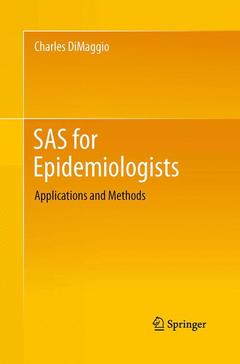SAS for Epidemiologists, Softcover reprint of the original 1st ed. 2013 Applications and Methods
Auteur : DiMaggio Charles

This comprehensive text covers the use of SAS for epidemiology and public health research. Developed with students in mind and from their feedback, the text addresses this material in a straightforward manner with a multitude of examples. It is directly applicable to students and researchers in the fields of public health, biostatistics and epidemiology. Through a ?hands on? approach to the use of SAS for a broad number of epidemiologic analyses, readers learn techniques for data entry and cleaning, categorical analysis, ANOVA, and linear regression and much more. Exercises utilizing real-world data sets are featured throughout the book. SAS screen shots demonstrate the steps for successful programming.
SAS (Statistical Analysis System) is an integrated system of software products provided by the SAS institute, which is headquartered in California. It provides programmers and statisticians the ability to engage in many sophisticated statistical analyses and data retrieval and mining exercises. SAS is widely used in the fields of epidemiology and public health research, predominately due to its ability to reliably analyze very large administrative data sets, as well as more commonly encountered clinical trial and observational research data.
Dr. Charles DiMaggio is associate professor in the departments of anesthesiology and epidemiology at Columbia University’s College of Physicians and Surgeons and the Mailman School of Public Health. He is an injury epidemiologist whose work includes describing and analyzing the epidemiology of pediatric pedestrian injuries for the New York City Department of Transportation, establishing a surveillance program to track and explain the behavioral health effects of the terrorist attacks of September 11th, 2001 in New York, and investigating the developmental and behavioral effects of anesthesia on young children. He has an active interest in the application of epidemiological approaches to large data sets, and teaches introductory and advanced methods using the SAS and R programming languages. Dr. DiMaggio's previous positions include chief research scientist with the Nassau County, NY, Department of Health where he worked on a variety of projects including bioterrorism preparedness, syndromic surveillance, and health disparities, and as chief physician assistant and director of research for the emergency department at Mt. Sinai School of Medicine at Elmhurst Hospital Center in NY.
Ouvrage de 258 p.
15.5x23.5 cm
Ouvrage de 258 p.
15.5x23.5 cm
Thèmes de SAS for Epidemiologists :
Mots-clés :
Bioinformatics; Clinical Trials; Epidemiology; Observational Studies; SAS


